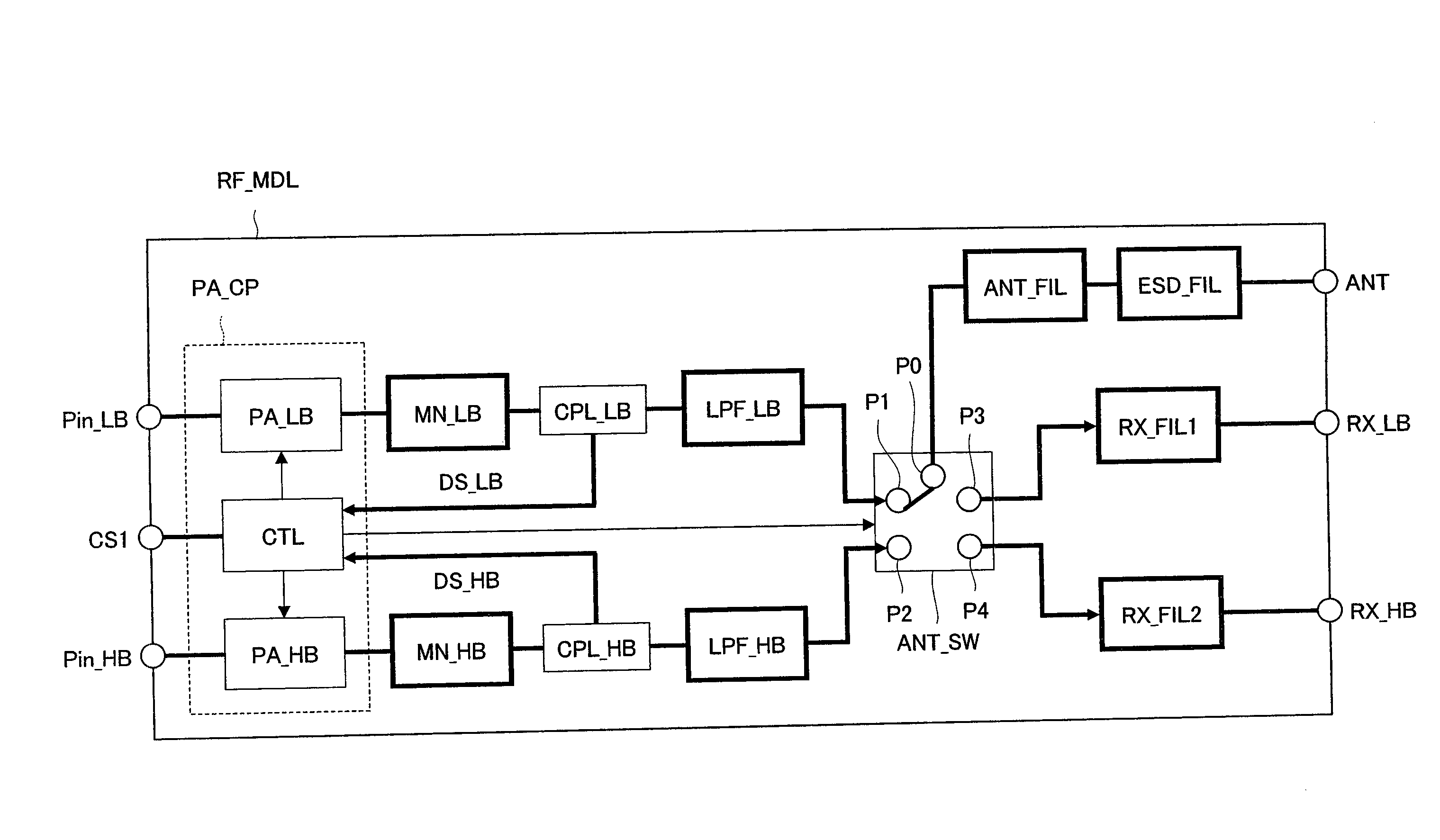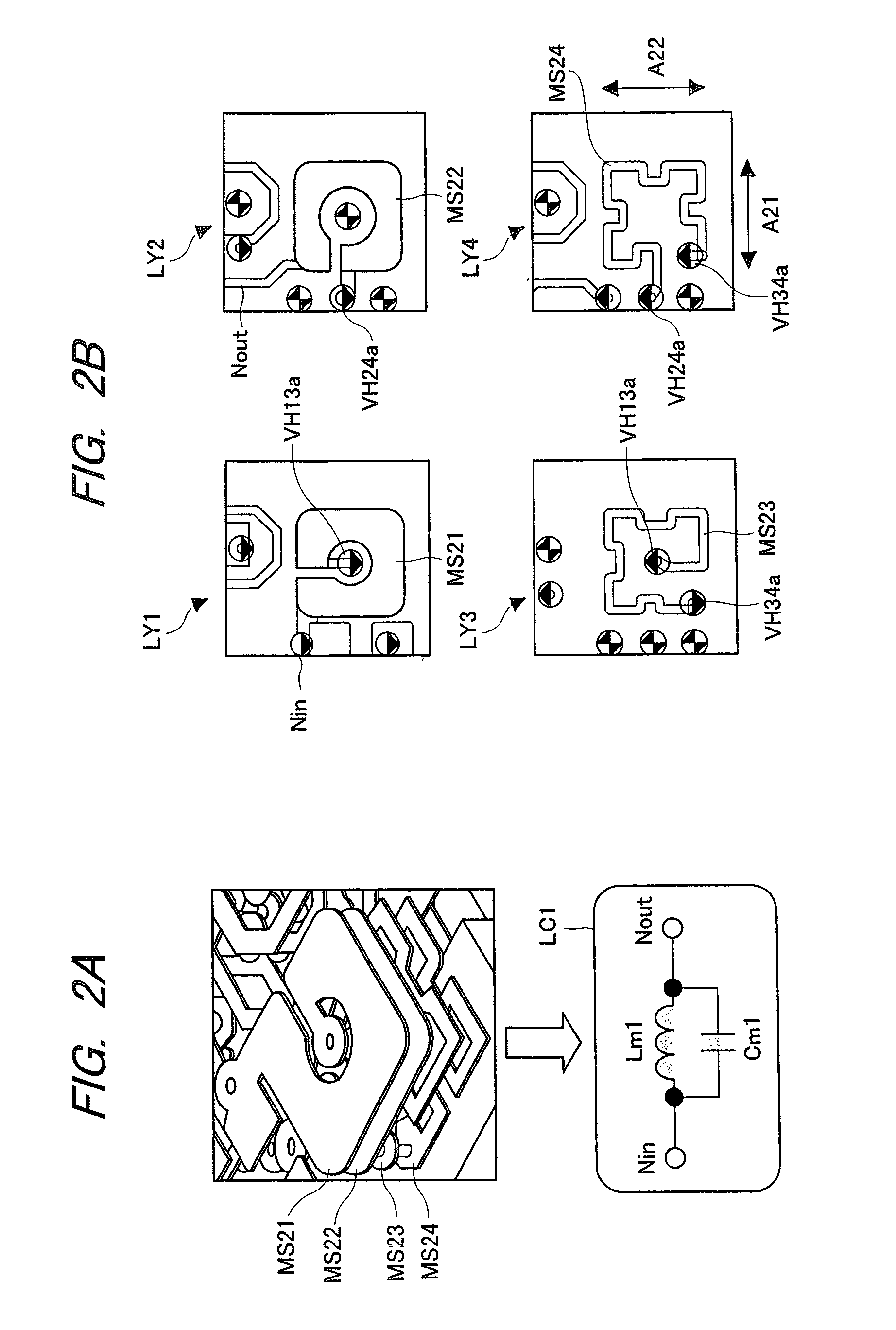Electronic device and RF module
a technology of electronic devices and modules, applied in the field of electronic devices, can solve the problems of increasing circuit area, affecting power efficiency, and difficulty in reducing or costing, so as to prevent the deterioration of power efficiency due to impedance mismatching and reduce the reflection of signals
- Summary
- Abstract
- Description
- Claims
- Application Information
AI Technical Summary
Benefits of technology
Problems solved by technology
Method used
Image
Examples
first embodiment
[0121]FIG. 1 is a block diagram showing an example of the configuration of an RF module according to a first embodiment of the invention. An RF module (radio frequency power amplifying module) of the first embodiment is used in, for example, a mobile communication device such as a cellular telephone and is designed to support both of a low frequency band and a high frequency band. For example, the low band includes GSM (Global System for Mobile Communication) 850 or GSM 900 or the like, and the high band includes GSM 1800 or GSM 1900. Here, GSM means a standard of a wireless communication protocol used in the digital mobile phones. GSM includes four available radio wave frequency bands, and a band of 900 MHz (880 to 960 MHz) is referred to as GSM900 or simply as GSM. Also, a band of 1800 MHz (1710 to 1880 MHz) is referred to as GSM1800, DCS1800 or PCN. Also, a band of 1900 MHz (1850 to 1990 MHz) is referred to as GSM1900, DCS1900, or PCS (Personal Communication Services). GSM1900 is...
second embodiment
[0143]In the second embodiment, an example of a configuration of a resonant circuit, which is used in the various filter circuits and the output matching circuits shown in FIG. 1 but is different from the that shown in FIG. 2A and FIG. 2B, will be described. FIG. 5 shows an example of the configuration of a resonant circuit according to the second embodiment of the present invention, in which FIG. 5A is a perspective view of the resonant circuit and FIG. 5B is a plan view illustrating the respective layers shown in FIG. 5A. Similar to that shown in FIG. 2A and FIG. 2B, the resonant circuit shown in FIG. 5A and FIG. 5B is achieved by using, for example, a four layered multilayer wiring substrate including a first wiring layer LY1 to a fourth wiring layer LY4, and the rear surface of LY4 serves as a ground electrode.
[0144]Wiring patterns MS31 and MS32 each of which is formed from an approximately loop-shaped line are formed in LY1 and LY2. Wiring patterns (electrode pattern) MS33 and ...
third embodiment
[0153]In the third embodiment, a configuration example in the case where the parallel resonant circuit LC1 in FIG. 2A and FIG. 2B and the parallel resonant circuit LC2 in FIG. 5A and FIG. 5B are applied to the RF module in FIG. 1 will be described in detail. FIG. 8 is a circuit diagram showing an example of a configuration in an RF module according to the third embodiment of the present invention. In the RF module shown in FIG. 8, as described in FIG. 1, an output from the power amplifier circuit PA_LB for low band is transmitted to the antenna switch circuit ANT_SW via the output matching circuit MN_LB, the coupler circuit CPL_LB, the low-pass filter circuit LPF_LB and the capacitor Cs13. Here, the output of PA_LB formed in a semiconductor chip is connected to MN_LB formed on the wiring substrate via a bonding wire or the like. Further, Cs13 is a capacitor for cutting direct current and is formed from, for example, SMD components.
[0154]PA_LB is, for example, an amplifier circuit ha...
PUM
 Login to View More
Login to View More Abstract
Description
Claims
Application Information
 Login to View More
Login to View More - R&D
- Intellectual Property
- Life Sciences
- Materials
- Tech Scout
- Unparalleled Data Quality
- Higher Quality Content
- 60% Fewer Hallucinations
Browse by: Latest US Patents, China's latest patents, Technical Efficacy Thesaurus, Application Domain, Technology Topic, Popular Technical Reports.
© 2025 PatSnap. All rights reserved.Legal|Privacy policy|Modern Slavery Act Transparency Statement|Sitemap|About US| Contact US: help@patsnap.com



